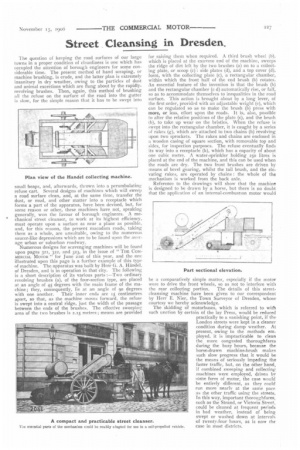Street Cleansing in Dresden.
Page 23

If you've noticed an error in this article please click here to report it so we can fix it.
The question of keeping the road surfaces of our large towns in a proper condition of cleanliness is one which has occupied the attention of borough engineers for some considerable time. The present method of hand scraping, or machine brushing, is crude, and the latter plan is extremely insanitary in dry weather, owing to the particles of dust and animal excretions which are Hung about by the rapidlyrevolving brushes. Then, again, this method of brushing all the refuse on the surface of the road into the gutter is slow, for the simple reason that it has to be swept into small heaps, and, afterwards, thrown into a perambulating refuse cart. Several designs of machines which will sweep a road surface clean, and, at the same time, transfer the dust, or mud, and other matter into a receptacle which forms a part of the apparatus, have been devised, but, for some reason or other, these machines have not, speaking generally, won the favour of borough engineers. A mechanical street cleanser, to work at its highest efficiency, must operate upon a surface as near a plane as possible, and, for this reason, the present macadam roads, taking them as a whole, are unsuitable, owing to the numerous saucer-like depressions which are to be found upon the average urban or suburban roadway.
Numerous designs for scavenging machines will be found upon pages 321, 322, and 323, in the issue of " THE COMMERCIAL Movja " for June 21st of this year, and the one illustrated upon this page is a further example of this type of machine. The apparatus was built by Herr G. A. Handel, of Dresden, and is in operation in that city. The following is a short description of its various parts :—Two ordinary revolving brushes (a), of the four-section type, are placed at an angle of 45 degrees with the main frame of the machine; they, consequently, lie at an angle of go degrees
with one another. Their inner ends are 15 centimetres apart, so that, as the machine moves forward, the refuse is swept into a central ridge, just the width of the passage between the ends of the brushes. The effective sweeping area of the two brushes is 2.15 metres; means are provided
for raising them when required. A third brush wheel (b), which is placed at the extreme end of the machine, sweeps the ridge of dirt left by the two brushes (a) on to a collecting plate, or scoop (c) : side plates (d), and a top cover (d), form, with the collecting plate (c), a rectangular chamber, within which the front half of the end brush (b) rotates. An essential feature of the invention is that the brush (b) and the rectangular chamber (c d) automatically rise, or fall, so as to accommodate themselves to inequalities in the road surface. This action is brought about by a long lever, of the first order, provided with an adjustable weight (e), which can be regulated so as to make the brush (b) press with more, or less, effort upon the roads. It is, also, possible to alter the relative positions of the plate (c), and the brush (p), to take up wear on the bristles. When the refuse is ;‘,.,ept into the rectangular chamber, it is caught by a series of rakes (g), which are attached to two chains (h) revolving upon two sprockets. The rakes and chains are enclosed in a wooden casing of square section, with removable top and sides, for inspection purposes. The refuse eventually finds its way into a receptacle (k), which has a capacity of about one cubic metre. A water-sprinkler holding 250 litres is placed at the end of the machine, and this can be used when the roads are dry. The two front brushes are driven by means of bevel gearing, whilst the tail brush, and the elevating rakes, are operated by chains : the whole of the mechanism is worked from the back axle.
Reference to the drawings will show that the machine is designed to be drawn by a horse, but there is no doubt that the application of an internal-combustton motor would he a comparatively simple matter, especially if the motor were to drive the front wheels, so as not to interfere with
the rear collecting portion. The details of this streetcleansing machine have been given to our correspondent by Herr E. Nier, the Town Surveyor of Dresden, whose courtesy we hereby acknowledge.
The skidding of motorbuses, which is referred to with such unction by certain of the lay Press, would be reduced practically to a vanishing point, if the London streets were kept in a cleaner condition during damp weather. At present, owing to the methods employed, it is impracticable to clean the more congested thoroughfares during the busy hours, because the horse-drawn machine-brush makes such slow progress that it would he the means of seriously impeding the faster traffic, but, on the other hand, if combined sweeping and collecting machines were employed, driven by -,ome form of motor, the case would run more nearly at the same pace be entirely different, as they could as the other traffic using the streets. In this way, important thoroughfares, such as the Strand, or Victoria Street, could be cleaned at frequent periods in bad weather, instead of being swept or washed down at interval% of twenty-four hours, as is now the case in most districts.


























